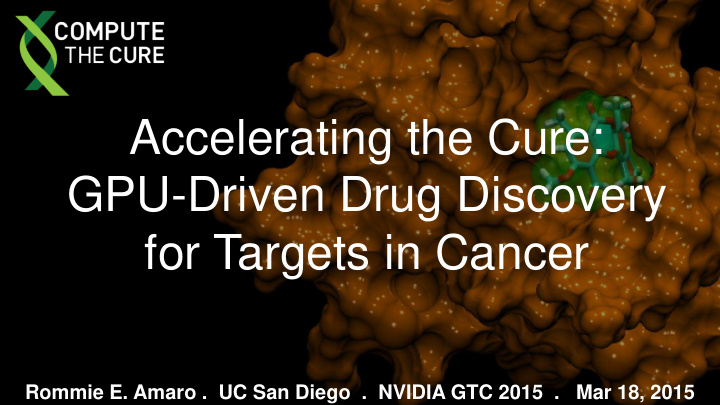



Accelerating the Cure: GPU-Driven Drug Discovery for Targets in Cancer Rommie E. Amaro . UC San Diego . NVIDIA GTC 2015 . Mar 18, 2015
Game-changing advances LCF Mira 786k cores Titan 280k cores + GPUs 2015 Enveloped virus 200 mil+ atoms 1-100 μs Ranger Compute 60k CPUs Power 2007 ribosome LeMieux 2 mil atoms 3k CPUs SGI Origin HP 735 100s ns 128 CPUs 12 CPUs 2002 ATPase 1993 1997 500k protein ion atoms 10k atoms channel time 10s ns 100s ps 100k atoms 1 ns Enormous gains in computing power enabling new frameworks for drug discovery
Computational Microscope views the Cell The photosynthetic chromatophore ( 10 8 atoms ) Computational Microscope water channel ( 10 5 atoms ) Physics fi brinogen ( 10 6 atoms ) lipoprotein ( 10 5 atoms ) Software & Tools NAMD, AMBER, CADD pipeline, FTProd … Supercomputers & GPUs 100 - 1,000,000 bacterial fl agellum ( 10 9 atoms ) Sustained 10 15 - 10 18 FLOPS processors vesicle formed by BAR domains ( 5x10 7 atoms ) Klaus Schulten, UIUC
Influenza Cancer Chlamydia Trypanosomiasis
Game changing GPU advances … life changing advances in drug discovery Amaro et al, PNAS 2008 Durrant et al PLOS NTD 2010 Trypanosomiasis Gabrielsen et al, PLOS One 2012 Yersinia pestis Cheng et al, J Med Chem 2007 Landon et al, CBDD, 2009 Chen et al, ACS Med Chem Lett 2013 Influenza Demir et al, PLOS Comp Biol 2011 Wassman et al, Nat Comm 2013 Cancer
p53: Guardian of the genome Frequency of p53 mutations in cancer >600,000 new cancer patients annually in the US with p53 point mutations Susceptible to oncogenic mutations that inactivate by lowering its stability Cancer mutations Cancer rescue mutations Brown et al. (2009) Nature Reviews. Cancer, 9(12), 862 – 873
Dream of cancer biologists: small-molecule p53 reactivation + = Cancer mutant Anti-Cancer Inactive p53 Reactivated p53 Drug NSC319725 Identified covalent attachment of products, but could not discern which of 10 cysteine residues
Simulations Reveal Target Flexibility 5% exposed, matches NMR Wassman, Baronio, Demir, et al. Nature Comm., (2013)
New Site Opens X-ray structure “Open” MD structure Wassman, Baronio, Demir, et al. Nature Comm., (2013)
New Site is Druggable “Open” MD structure Wassman, Baronio, Demir, et al. Nature Comm., (2013) Vajda et al., Computational Solvent Mapping: http://ftmap.bu.edu/
Discovery of novel reactivation compound & rationalization of clinical trial compound Receptor Ensemble Dose-dependent Ligands rescue in mammalian NCI Diversity Set cancer cells ~2000 compounds Structures: + X-ray & MD AutoDock Vina Post-Processing RCS rescoring binding spectrum Stictic acid Experimental testing Wassman, Baronio, Demir, et al. Nature Comm., (2013)
Our computational approach discovers more novel p53 reactivation compounds in 6 months than all the research efforts of the previous 20 years combined 15/138 compounds tested in mammalian cancer cell lines rescue p53 activity and kill cancer cell
1:3
Scalable Drug Discovery BENEFITS: • Increase reuse • Reproducibility Se S no p53 cancer cell with p53-R175H mutant • Scale execution, 1 cell proliferation 0.8 reactivation problem & solution compounds kill 0.6 cells with p53 • 0.4 Compare methods cancer mutant 0.2 • Training 0 medium Prima-1 Stictic acid 35ZWF 25KKL 22LSV 32CTM 26RQZ 27WT9 33AG6 33BAZ 28NZ6 27TGR 27VFS 35LWZ 36EB5 27UDP 32LDE 15 new reactivation compounds Ieong et al., 2014
AMBER GPU MD Workbench Minimization Actor Equilibration Actor
Nimble execution on most efficient platforms NSF/DOE: Tera/Peta Cloud: Local: Desktop or Scale Resources Amazon Cluster (XSEDE) Coming soon! Comet Stampede
Tool & tutorial is available for download: http://amarolab.ucsd.edu/resources.html Contact: ramaro@ucsd.edu “Hands on” workshop coming soon!
Recommend
More recommend